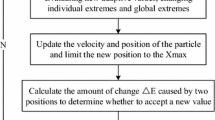Abstract
Deficiencies of applying the traditional least squares support vector machine (LS-SVM) to time series online prediction were specified. According to the kernel function matrix’s property and using the recursive calculation of block matrix, a new time series online prediction algorithm based on improved LS-SVM was proposed. The historical training results were fully utilized and the computing speed of LS-SVM was enhanced. Then, the improved algorithm was applied to time series online prediction. Based on the operational data provided by the Northwest Power Grid of China, the method was used in the transient stability prediction of electric power system. The results show that, compared with the calculation time of the traditional LS-SVM(75-1 600 ms), that of the proposed method in different time windows is 40–60 ms, and the prediction accuracy(normalized root mean squared error) of the proposed method is above 0.8. So the improved method is better than the traditional LS-SVM and more suitable for time series online prediction.
Similar content being viewed by others
References
KUGIUMTZIS D, LINGIARDE O C, CHRISTOPH-ERSEN N. Regularized local linear prediction of chaotic time series[J]. Physica D, 1998, 11(2): 344–360.
WHITEHEAD B A, CHOATE T D. Cooperative-competitive genetic evolution of radial basis function centers and widths for time series prediction[J]. IEEE Transactions on Neural Networks, 1996, 7(4): 869–880.
YEE P, HAYKIN S. A dynamic regularized radial basis function network for nonlinear, nonstationary time series prediction[J]. IEEE Transactions on Signal Processing, 1999, 47(9): 2503–2521.
GENCAY R, LIU T. Nonlinear modeling and prediction with feedforward and recurrent networks[J]. Physica D, 1997, 10(8): 119–134.
YU Li-xin, ZHANG Yan-qing. Evolutionary fuzzy neural networks for hybrid financial prediction[J]. IEEE Transactions on Systems, Man and Cybernetics, Part C, 2005, 35(2): 244–249.
GHAZALI R, HUSSAIN A, EL-DEREDY W. Application of ridge polynomial neural networks to financial time series prediction[C]// International Joint Conference on Neural Networks. Vancouver, BC, Canada: Tyndale House Press, 2006: 235–239.
VAPNIK V N. The Nature of Statistical Learning Theory[M]. New York: Spring-Verlag Press, 1995.
CHERKASSKY V, MULIER F. Learning from Data-Concepts: Theory and Methods[M]. New York: John Wiley Sons Press, 1998.
JOACHIMS T. Text categorization with support vector machines: learning with many relevant features[C]// Proceedings of the European Conference on Machine Learning(ECML). Paris: John Wiley Sons Publisher, 1998: 137–142.
GUYON I, WESTON J, BARNHILL S. Gene selection for cancer classification using support vector machines[J]. Machine Learning, 2002, 46(1): 389–422.
HE Xue-wen, ZHAO Hai-ming. Support vector machine and its application to machinery fault diagnosis[J]. Journal of Central South University of Technology: Natural Science, 2005, 36(1): 97–101. (in Chinese)
ZHONG Wei-min, PI Dao-ying, SUN You-xian. Support vector machine based nonlinear model multi-step-ahead optimizing predictive control[J]. Journal of Central South University of Technology, 2005, 12(5): 591–595.
KIVINEN J, SMOLA A, WILLIAMSON R. Online learning with kernels: Advances in Neural Information Processing Systems[M]. Cambridge, MA: MIT Press, 2002.
RALAIVOLA L. Incremental support vector machine learning: A local approach[C]// Proceedings of the International on Conference on Artificial Neural Networks. Vienna: St Martin Publisher, 2001: 322–329.
KUH A. Adaptive kernel methods for CDMA systems[C]// Proceedings of the International Joint Conference on Neural networks. Washington DC: Spring-Verlag Publisher, 2001: 1404–1409.
SUYKENS J, VANDEWALE J. Least squares support vector machine classifiers[J]. Neural Processing Letters, 1999, 9(3): 293–300.
Author information
Authors and Affiliations
Corresponding author
Additional information
Foundation item: Project (SGKJ[200301-16]) supported by the State Grid Cooperation of China
Rights and permissions
About this article
Cite this article
Wu, Q., Liu, Wy. & Yang, Yh. Time series online prediction algorithm based on least squares support vector machine. J Cent. South Univ. Technol. 14, 442–446 (2007). https://doi.org/10.1007/s11771-007-0086-0
Received:
Accepted:
Published:
Issue Date:
DOI: https://doi.org/10.1007/s11771-007-0086-0




